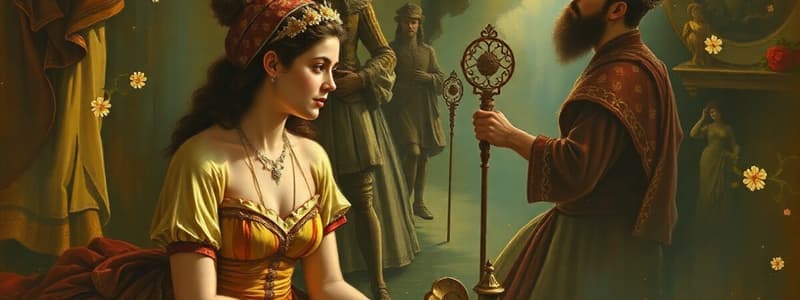Podcast
Questions and Answers
What influence did silent films have on film genres?
What influence did silent films have on film genres?
- They had no influence
- They were purely educational
- They established today’s genres (correct)
- They only influenced comedy
Name an example of how the film industry responded to television competition in the 1950s.
Name an example of how the film industry responded to television competition in the 1950s.
Introduction of widescreen formats.
The ______ is known for its self-censorship in the film industry.
The ______ is known for its self-censorship in the film industry.
Hays Code
The 'Talkies' marked the end of the golden age of silent films.
The 'Talkies' marked the end of the golden age of silent films.
What were two major advantages of vertical integration in the 1930s Hollywood studio era?
What were two major advantages of vertical integration in the 1930s Hollywood studio era?
What is one disadvantage of vertical integration in the Hollywood studio era?
What is one disadvantage of vertical integration in the Hollywood studio era?
Which film is credited as the first 'Talkie'?
Which film is credited as the first 'Talkie'?
Match the following silent films with their genres:
Match the following silent films with their genres:
What is one strategy modern movie industry employs to remain profitable?
What is one strategy modern movie industry employs to remain profitable?
The introduction of ______ significantly impacted how films were produced and consumed.
The introduction of ______ significantly impacted how films were produced and consumed.
Flashcards
Early Film Genres
Early Film Genres
Early film categories like Westerns, war movies, and comedies.
Hollywood Studio System
Hollywood Studio System
Hollywood's structured method of film production in the early 1900s.
Rise of the Star System
Rise of the Star System
Actors like Valentino and Chaplin rose to fame.
Vertical Integration
Vertical Integration
Signup and view all the flashcards
Response to Television
Response to Television
Signup and view all the flashcards
Rear Projection
Rear Projection
Signup and view all the flashcards
Compositing
Compositing
Signup and view all the flashcards
Postproduction
Postproduction
Signup and view all the flashcards
Studio Executives
Studio Executives
Signup and view all the flashcards
Writers
Writers
Signup and view all the flashcards
Study Notes
Film and Video History
- Silent films influenced how we classify movies today.
- Some early film genres include Westerns, War movies, horror, romance, comedies, dramas, documentaries, and action/adventure.
- The development of "talkies" led to major changes in the film industry, with the introduction of dialogue and sound.
The "Golden Age" of Hollywood
- The Hollywood film studio system emerged around the early 1900s with production studios creating an assembly line-style method for making films.
- The rise of the Hollywood star system was characterized by the rise of popular actors like Valentino, Gish, Pickford, and Chaplin.
- The film industry faced various challenges in the 1930s, including the Hays Code, which implemented strict self-censorship guidelines.
- The 1940s saw the peak of motion picture impact, with massive cultural influence and attendance reaching 70 million tickets a week.
- The popularity of film allowed people to escape the realities of the Depression era.
Vertical Integration
- The studio system of the 1930s and 40s relied heavily on vertical integration where film studios controlled production, distribution, and exhibition.
- The major studios owned production companies, distribution networks, and movie theaters, which led to the creation of both high-quality films and "B" movies, which were less expensive and aimed at a specific audience.
- This system, however, attracted scrutiny from the U.S. government.
- Despite the rise of the studio system, each studio had unique aspects that differentiated their films.
Impact of New Technologies
- The 1950s were a pivotal period as television's growing popularity challenged movie studios.
- Studios responded by:
- Producing movies with more thrilling and larger-than-life content aimed at a broader audience.
- Experimenting with new technologies, including 3D films, and focusing on more mature themes.
- By the 1960s and beyond, the film industry adopted new technologies like film ratings and DVDs.
Movie Production Today
- The modern movie industry has faced its own set of challenges as the digital marketplace has rapidly expanded.
- The industry remains agile with these strategies:
- Creating major blockbusters with high marketing budgets.
- Focusing on the lucrative international markets.
- Producing more niche films, particularly through independent production.
- Indie production is a growing force in the movie industry, and studio productions focus on large-scale blockbuster productions.
Modern Filmmaking Terms
- Rear Projection: A technique where a pre-recorded background image is projected onto a screen behind the actors.
- Front Projection: Similar to rear projection, a background image is projected onto a screen in front of the actors.
- Compositing: Combining multiple images or video elements into a single image.
- Matte: A painted or digitally created mask used to isolate sections of an image during compositing or special effects.
- Postproduction: All aspects of filmmaking that occur after the initial filming or recording, including editing, sound design, special effects, and color correction.
- Nonlinear Editing: A method where the editing process is not chronological, but instead involves the user easily moving and manipulating different parts of the video.
Movie Making Roles
- Studio Executives: Oversee the overall operation of the studio, including financial decisions, production schedules, and talent acquisitions.
- Producers: Responsible for the overall production of the film, from preproduction to postproduction, and oversee budgeting, casting, and scheduling.
- Writers: Create the script for the film based on a story, concept.
- Guilds: Represent and protect the interests of various film professionals, such as actors, directors, writers, and crew members.
- Talent: A general term for actors, directors, and other creative personnel who work on the film.
- Distributors: Companies responsible for distributing films to theaters, streaming services, and other platforms.
- Audience Members: The individuals who watch and experience the film.
Studying That Suits You
Use AI to generate personalized quizzes and flashcards to suit your learning preferences.




